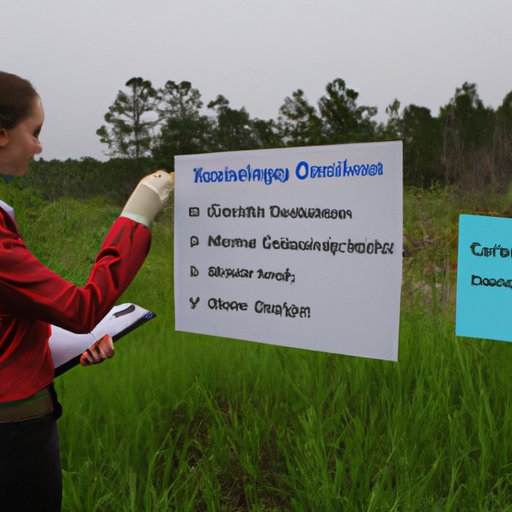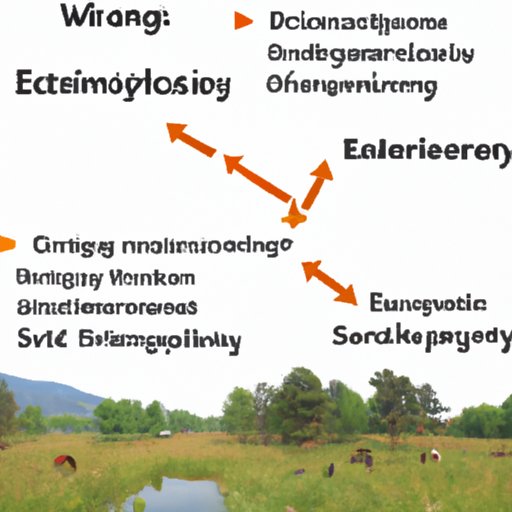Introduction
Environmental science is a broad field that combines elements from the physical sciences, social sciences, and humanities to better understand the complex relationship between humans and their environment. It is an interdisciplinary field of study that draws from multiple disciplines to provide a holistic view of global environmental issues. This article will explore how environmental science is interdisciplinary, examining the different disciplines that contribute to environmental science and looking at the ways in which it is impacting other fields.
Examining How Environmental Science Draws from Multiple Disciplines
Environmental science is a multidisciplinary field that draws from the physical sciences, social sciences, and humanities. Physical sciences such as geology, chemistry, and physics provide a foundation for understanding the physical aspects of the environment, while social sciences such as sociology, anthropology, economics, and political science help to provide an understanding of the social and cultural dynamics of human-environment interactions. Humanities disciplines such as philosophy, history, and ethics provide insight into the ethical and moral implications of environmental science and its applications.
Each discipline contributes to the overall understanding of global environmental challenges. For example, geology provides a foundation for understanding the physical processes that shape the Earth’s surface, while sociology helps to provide an understanding of how people interact with the environment. Additionally, economics can be used to analyze the economic costs and benefits associated with various environmental policies. These different disciplines come together to form a comprehensive view of global environmental issues.

Analyzing How Environmental Science is Impacting Other Fields
Environmental science is having a profound impact on other fields, including policy, economics, and public health. Policymakers are increasingly relying on environmental science when making decisions about environmental regulations and conservation efforts. Economics is being influenced by environmental science, as economists are taking into account environmental costs and benefits when analyzing economic data. Public health is also being impacted by environmental science, as researchers are using environmental data to better understand the connections between environmental factors and human health.
For example, a recent study published in the journal Nature found that air pollution is linked to an increased risk of cardiovascular disease. The study used data from satellite imagery, ground-based monitoring stations, and computer models to investigate the link between air pollution and cardiovascular health. The findings of the study demonstrate how environmental science is informing public health policies and research.

Comparing the Different Methodologies of Environmental Science to Other Disciplines
Environmental science is distinct from other disciplines in its approach to solving global challenges. While many disciplines rely heavily on theory and abstract models, environmental science often relies on real-world data and empirical evidence. This difference in methodology has led to some debate among scholars over the validity of environmental science as a legitimate field of study.
However, environmental science has been able to bridge the gap between theory and practice by combining traditional methods with more modern approaches. For instance, environmental scientists have used mathematical models to simulate the effects of climate change, while also utilizing observational data to verify the accuracy of the models. This combination of theoretical and empirical approaches has enabled environmental science to make meaningful contributions to the understanding of global environmental challenges.

Discussing the Role of Interdisciplinary Collaboration in Advancing Environmental Science
Interdisciplinary collaboration is essential for advancing environmental science. By bringing together experts from different disciplines, researchers are able to gain a more comprehensive understanding of global environmental challenges. Additionally, collaboration between disciplines allows for the exchange of ideas and knowledge, which can lead to new insights and innovative solutions.
For example, a recent study published in the journal Science investigated the impact of urbanization on water resources. The study was conducted by a team of researchers from multiple disciplines, including hydrology, ecology, and economics. The results of the study demonstrated the importance of interdisciplinary collaboration in advancing environmental science, as the combination of different perspectives and methodologies enabled the researchers to gain a deeper understanding of the impacts of urbanization on water resources.
Conclusion
Environmental science is an interdisciplinary field of study that draws from multiple disciplines to provide a comprehensive understanding of global environmental challenges. Each discipline contributes to the overall understanding of global environmental issues, while environmental science is also having a profound impact on other fields, such as policy, economics, and public health. Additionally, environmental science has bridged the gap between theory and practice by combining traditional methods with more modern approaches. Finally, interdisciplinary collaboration is essential for advancing environmental science, as it allows for the exchange of ideas and knowledge, which can lead to new insights and innovative solutions.
In conclusion, environmental science is an interdisciplinary field that draws from multiple disciplines to provide a comprehensive understanding of global environmental challenges. Interdisciplinary collaboration is essential for advancing environmental science, as it allows for the exchange of ideas and knowledge, which can lead to new insights and innovative solutions.
(Note: Is this article not meeting your expectations? Do you have knowledge or insights to share? Unlock new opportunities and expand your reach by joining our authors team. Click Registration to join us and share your expertise with our readers.)
